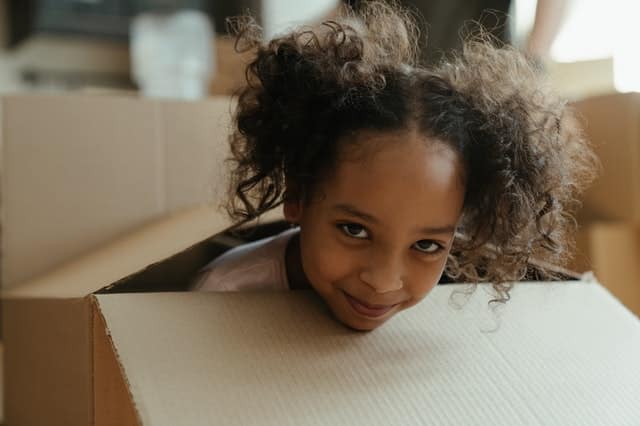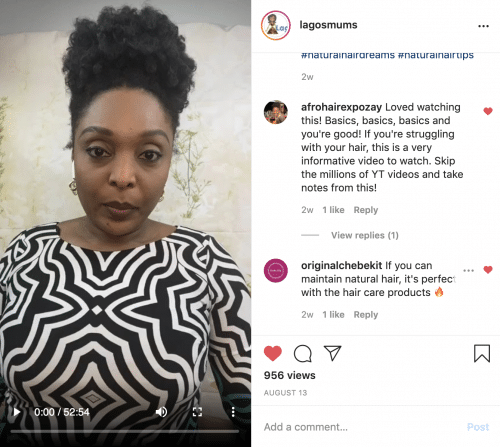Taking care of our hair as women is an important part of our daily lives. LagosMums hosted Kemi Lewis on an Instagram live session as she discussed caring for our hair.
This is something that a lot of people, particularly in the last couple of months, due to the pandemic have been struggling with. She shared a few tips in understanding the basics; in terms of hair care, products and styling.

Taking Care of Young Girls’ Hair
One of the things to ensure when taking care of young girls’ hair is keeping them engaged. Because a lot of times, unfortunately, a lot of children have associated wash day with pain. So the minute you tell them, it’s time to wash your hair or time to go to the salon; there is a whole lot of drama. This is because they have associated making their hair with a very painful process; which really should not be.

Parents need to understand the basics and prevent pain. A lot of women struggle with natural hair not because natural hair is hard as everybody says; but because it’s not something most of us grew up understanding. This is because most women have been used to applying hair relaxers, and do not know how to deal with natural hair; as the practices adopted to taking care of both are different.
Understanding Natural Hair
Women need to understand how natural hair works and then begin to adopt the practices that will fit into a natural hair regimen. One of the things to understand with natural hair is that; unlike relaxed hair that is straight, natural hair has more curly strands. So there is a tendency for them to wrap around one another and it is that wrapping around that causes knots and tangles in the hair. As a result, when trying to untangle, most women experience pain, breakage and a lot of things that most women associate with having natural hair.

Therefore, in understanding your natural hair journey, one of the things to keep in mind is keeping the hair in some form of a stretched-out state. This could be in twists, single plaits, weaving and so much more.
Don’t Talk Down On Your Hair
Most women just talk down on their hair, and honestly words as so powerful. Nobody’s hair is better than the next; everybody has great hair. It is really what you are doing to your hair that will determine the results.
Everybody’s hair is of a different texture, growth rates, porosity levels, and other factors. So, comparing your hair to another person’s is just you setting yourself up for disappointment. Most women complain of a lack of hair growth, but this is usually due to loss of hair at the tips at the same rate or faster than it is growing from the root.
4 Step Hair Regimen
A regimen is what you do to your hair on a regular basis; daily, weekly or monthly. It is important to keep your regimen; simple, straightforward and address basic things such as dryness.

1. Cleansing or Shampooing
The first step is to ensure cleansing the hair regularly which is ideally every 7 to 10 days; at most every two weeks. W
ashing the hair is basically taking care of the scalp, and ensuring that the foundation from which the hair is growing is kept at an optimal level. It is essential to apply water to the hair or a pre-poo to reduce dryness before the actual shampooing process. It is necessary to detangle the hair before you shampoo.
2. Conditioning
The next thing we want to do is conditioning the hair. You want a moisturizing deep conditioner for your hair. This is because natural hair tends to be dry and what we are trying to do at every point is infuse moisture into the hair. Start applying from the tips all the way down to the roots. Do not apply conditioner on the scalp as this results in buildup on the scalp; where the scalp starts to flake or itch overtime.
The conditioner should be applied in sections and then cover the head with a shower cap or wrap with a hot towel; so as to open up the cuticles in the hair. The conditioner should not be left on for more than 15 to 20 minutes in your hair, then you want to rinse off with cool water; this will ensure the cuticles close up after opening, due to the previously applied heat. Next, apply a leave-in conditioner to your hair, especially at the weaker parts of your hair.
3. Moisturizing and Sealing
This step requires a method called LCO ( Liquid, Cream, Oil ). First start with applying a liquid to your hair; such as spritzing water. Then apply the cream; so this could be a thick cream, such as Avocado, mango or shea butter. After that, apply oil onto the hair: such as olive, grapeseed, coconut or sweet almond oil.
The liquid does the initial moisturizing. The cream is a thicker level that you then put on top of that and then the oil will help to lock everything into the hair. This will ensure that your hair stays moisturized for longer periods.
4. Protecting
This is essentially you protecting your hair from yourself. It is just simply putting your hair into a style that prevents you from constantly touching and manipulating the hair. So it could be putting your hair into a twist, single plaits, braids and so on. [Read also: Back to School Hairstyles for Black Children]
Ensure that your hairstyle is no too tight, else you run the risk of losing hair from your edges. When it comes to extensions, it is recommended that children do not put extensions in their hair until they are much older. This is because children’s hair follicles are still fragile and developing. Harsh hairstyles and excessive use of extensions can lead to hair loss later in life.
[Tweet “When it comes to extensions, it is recommended that children do not put extensions in their hair until they are much older.”]
Also, ensure continued moisturizing of hair; do this every one to three days depending on how dry your hair gets. When you’re sleeping at night, ensure that you wear a satin bonnet as that will also protect your hair. For younger children, you can also get them satin pillowcases if they cannot keep a bonnet on their hair. Satin or silk is preferable to cotton because cotton tends to suck out moisture from the hair.
COVID-19 Safety Precautions
The Lagos State Government had cleared salons to open. So, as salons are open, we need to find out what the health and safety protocols are for the salons. For example, is the salon offering booking times to reduce the number of clients, what are their mask or shield wearing rules; as well as the use of sanitizers or washing of hands.
Remember that taking care of your natural hair should not be painful, learning the basics of hair care will make it more manageable for all involved. READ ALSO [The Great Debate: Natural Hair or Not]
You can watch the replay as Kemi Lewis shared with us the basics of caring for your natural hair.
https://www.instagram.com/p/CD14zZBlKtM/
Kemi Lewis is referred to as THE QUEEN OF NATURALHAIR UPDOS and is the Founder of @klsnaturals. You can learn more about Kemi on here.



